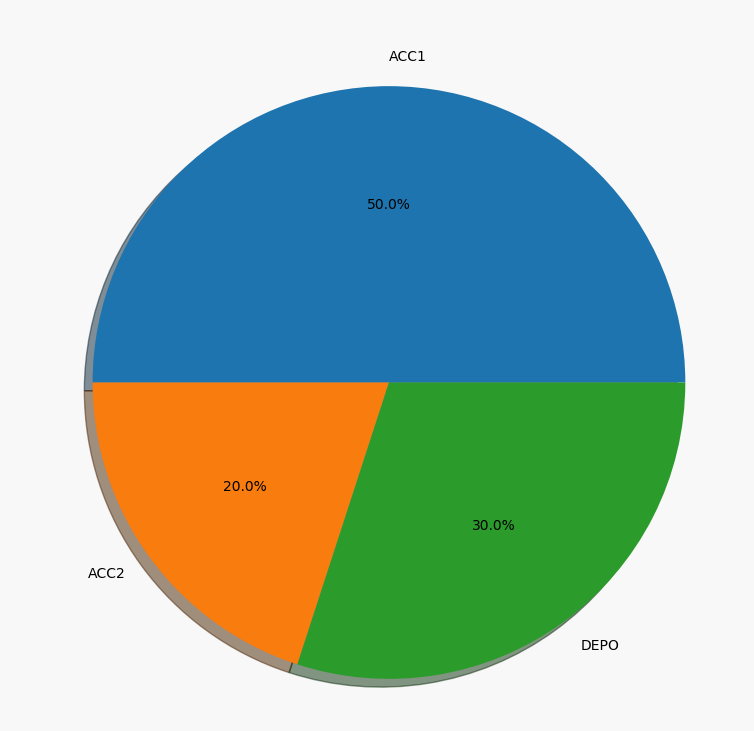Financial accounting library
Project description
Finac - financial accounting for humans
Finac is a library and function set for Jupyter/ipython, which provides a double-entry bookkeeping database.
Finac is simple, open and free. It can work with SQLite or any database supported by SQLAlchemy.



You can use Finac either in interactive mode with Jupyter, Spyder-IDE, ipython or other similar environment or embed Finac library into own projects. The library may be used in accounting applications as well it's useful for the fin-tech services.
Finac supports multiple currencies, simple transactions, double-entry bookkeeping transactions, watches overdrafts, balance limits and has many useful features, which make accounting simple and fun.
Install
pip3 install finac
Sources: https://github.com/alttch/finac
Documentation: https://finac.readthedocs.io/
How to use in interactive mode
Finac database contain 3 entity types:
-
currency asset currency, currencies "USD" and "EUR" are created automatically
-
account bank account, counterparty account, tax account, special account etc. Everything is accounts :)
-
transaction movements from (credit) / to (debit) and between accounts
Transactions can be simple (no counterparty) or classic double-entry bookkeeping (between debit and credit account)
import finac as f
# init finac,
f.init('/tmp/test.db')
# create a couple of accounts
f.account_create('acc1', 'USD')
f.account_create('acc2', 'USD')
f.account_create('depo', 'USD', 'saving')
# import initial balance with a simple transaction
f.tr('acc1', 10000, tag='import')
# move some assets to other accounts
f.mv(dt='acc2', ct='acc1', amount=2000)
f.mv(dt='depo', ct='acc1', amount=3000)
# display statement for acc1
f.ls('acc1')
id amount cparty tag note created completed
-----------------------------------------------------------------------------
7 10 000.00 import 2019-10-26 03:04:02 2019-10-26 03:04:02
8 -2 000.00 ACC2 2019-10-26 03:04:02 2019-10-26 03:04:02
9 -3 000.00 DEPO 2019-10-26 03:04:02 2019-10-26 03:04:02
-----------------------------------------------------------------------------
Debit turnover: 10 000.00, credit turnover: 5 000.00
Net profit/loss: 5 000.00 USD
# display summary for all accounts
f.ls()
account type currency balance balance USD
-------------------------------------------------
ACC1 current USD 5 000.00 5 000.00
ACC2 current USD 2 000.00 2 000.00
DEPO saving USD 3 000.00 3 000.00
-------------------------------------------------
Total: 10 000.00 USD
# display summary only for current accounts
f.ls(tp='current')
account type currency balance balance USD
-------------------------------------------------
ACC1 current USD 5 000.00 5 000.00
ACC2 current USD 2 000.00 2 000.00
-------------------------------------------------
Total: 7 000.00 USD
# display assets pie chart, (wrapper for matplotlib.pyplot, requires Jupyter,
# Spyder-IDE or similar interactive environment)
f.pie()

Note: when addressing currencies and accounts both in interactive and API mode, you should use account and currency codes as object identifiers. All codes are case-insensitive.
Inside database, Finac uses numeric IDs to connect objects, so all their codes can be changed without any problems.
Special features
Lazy exchange
Finac can automatically move assets between accounts with different currencies, if exchange rate is set or specified in transaction details:
# create EUR account
f.account_create('acc5', 'eur')
# set exchange rate (in real life you would probably use cron job)
f.currency_set_rate('eur/usd', value=1.1)
f.mv(dt='acc5', ct='acc1', amount=100)
hoorah, account acc5 got 100 EUR! And exchange rate was 1.1. Let's check:
>>> f.ls('acc1')
id amount cparty tag note created completed
-----------------------------------------------------------------------------
..............
..............
14 -110.00 2019-10-26 03:15:41 2019-10-26 03:15:41
-----------------------------------------------------------------------------
>>> f.ls('acc5')
id amount cparty tag note created completed
-----------------------------------------------------------------------
15 100.00 2019-10-26 03:15:41 2019-10-26 03:15:41
-----------------------------------------------------------------------
Debit turnover: 100.00, credit turnover: 0.00
Net profit/loss: 100.00 EUR
As you see, there's no counterparty account in lazy exchange. This feature is useful for personal accounting and special applications, but for the professional accounting, you should create counterparty exchange account and perform buy-sell transactions with it.
Targets
Targets is a feature I wrote Finac for. You have account balances in bank and in accounting. They differ by some amount and you are going to record this with a single transaction.
But the problem is there's a lot of transactions you should sum up. Or calculate the difference between bank balance and accounting. Pretty common, eh? Don't do this, we have targets.
Specifying targets instead of amount tells Finac to calculate transaction amount by itself.
After the previous operation, we have 4,890.00 USD on "acc1" and want to move all except $1000 to "acc2". Let's do it:
>>> f.mv(dt='acc2', ct='acc1', target_ct=1000)
id amount cparty tag note created completed
-----------------------------------------------------------------------------
......
......
16 -3 890.00 ACC2 2019-10-26 03:25:56 2019-10-26 03:25:56
-----------------------------------------------------------------------------
Debit turnover: 10 000.00, credit turnover: 9 000.00
Net profit/loss: 1 000.00 USD
The transaction amount is automatically calculated. Lazy people are happy :)
If you want to specify a debit account balance target instead, use target_dt function argument. Note: calculated transaction amount should be always greater than zero (if you try specifying credit account target higher than its current balance, you get ValueError exception)
For the simple transactions (f.tr(...))), use target=.
Transaction templates
Example: you have a recurrent payment orders in your bank, which pay office utility bills every 5th day of month, plus automatically moves $100 to saving account. To fill this into accounting, just create YAML transaction template:
transactions:
- account: acc1
amount: 200
tag: electricity
note: energy company deposit
- account: acc1
amount: 800
tag: rent
note: office rent
- dt: depo
ct: acc1
amount: 200
tag: savings
note: rainy day savings
then create a cron job which calls f.transaction_apply("/path/to/file.yml") and that's it.
Actually, transaction templates are useful for any recurrent operations. You may specify all same arguments, as for the core functions.
How to embed Finac library into own project
See Finac documentation for core function API details.
TODO
Finac is in alpha stage. We are continuously working on the features, speed and stability improvements as well as waiting your commits.
- Cross-currency rates
- Wrappers around some used SQL-formats to get rid of injections
- Portfolio management functions
- finac-cli
Project details
Release history Release notifications | RSS feed
Download files
Download the file for your platform. If you're not sure which to choose, learn more about installing packages.













